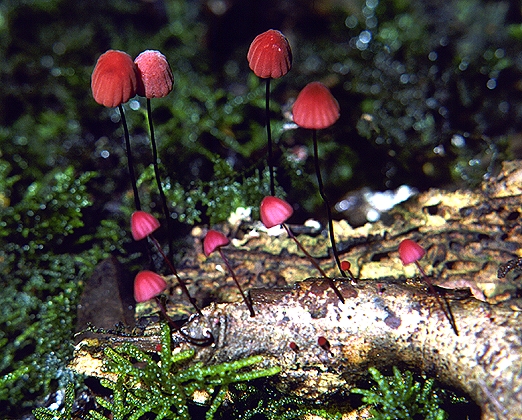
Marasmius spp.

Common name: None.
Description: The caps measure 12 cm in diameter and are acutely conical, dry, plicate and wavy at the margin; they are very thin and rather leathery. The colour is often brilliant red to maroon-red, but some species may be dark brown or cream-coloured. The gills are always widely spaced, more or less adnate and creamy white. The stems may be up to 7 cm long and 11.5 mm thick, are usually black, but almost always smooth, dry and resemble horse hair.
The spores are usually 612 µm in length; they are generally long-ellipsoidal to narrowly drop-shaped, always smooth and colourless, but white in mass.
Substratum: Species of Marasmius can be found in litter in tropical and subtropical rainforests and also in wet eucalypt and Nothofagus (beech) forests. They usually occur in twos or threes and are often overlooked as the fruiting bodies of these fungi tend to occur in rather sheltered locations.
Distribution: The species shown here were reported from forests in Queensland and New South Wales, but similar species are present in Victoria and Tasmania.
Notes: The description provided applies to several closely related species in Australian forests. There is no major work completed on Australian species of Marasmius and the species defined here are either undescribed or are species already known overseas but not yet recognised for Australia. These small species of Marasmius all have a very conical cap with thin, rather leathery flesh and stems that are black, shiny, very thin and quite tough. The word Marasmius comes from the Greek maraino (to die away), and these fungi have the ability to wither and shrivel up in dry weather but return to normal shape and colour when the next shower of rain moistens and revives them.

